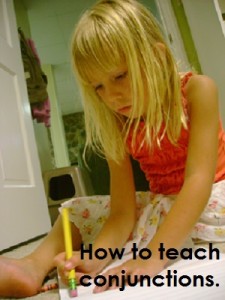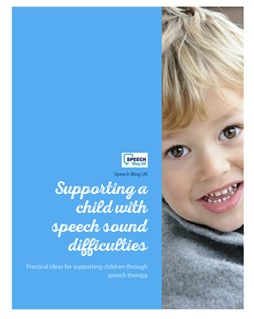So, conjunctions… Technically a conjunction is an invariable grammatical particle, and it may or may not stand between the items it conjoins. (That takes me back to my linguistic lectures!!) You might call them conjunctions or connectives, but what we are talking about are those clever little words that link ideas and sentences together.
Now we need to think about how to explain and teach that to a child with language difficulties! Today, I am going to talk through some ideas for the early conjunctions and show you how I teach them to Junior aged children with language difficulties (7-11). We all have those children who start to plateau when they get to level 2A (National Curriculum Level) and it is likely that to get them into level 3C they need to use conjunctions (and adjectives, but that’s a post for another day!)
I teach the terminology as I introduce the words. I love using the colour coded grammar systems and always talk about nouns and verbs, so it’s no different for conjunctions. We talk about conjunctions or connectives and that their job is to link ideas or sentences together – they are joining words. I use both words as teachers often use connectives, but I use conjunctions! I am also a firm believer in the child knowing what they are working on and why. So fingers crossed, if you asked them, they would remember that conjunctions are linking words and we need them to improve our talking and writing!
- And
I personally start with ‘and’. Hopefully they might be using it already so we can use it as an example. My rule for ‘and’ is that it can link any two things or sentences.
You can start with items that you would list – it’s an easy way to get an “and” in there! You might need to start with real objects. Ask the child to go and get two things/ toys, then you can model the structure “You are holding the pen and the car”. Repeat this for as long as needed. To make it more fun, you could use pictures or think up your own ideas. I like to think up silly things like “Elizabeth wants a giant anteater and a komodo dragon!” (these are my favourite animals – so I would!!). It makes it a bit more exciting and is great for extending vocabulary and descriptions.
From here I move on to linking sentences. If you are teaching in a group, you could use the children as examples (most children seem to enjoy this). Make up two sentences about what the children are doing. e.g. Sally is sitting down. Fred is staring out of the window. I write these on the board. We then discuss where the ‘and’ needs to go – between the sentences, and also what else we need to change – take out the full stop, if not a name you might need to change a capital letter etc. Again it doesn’t matter if these are silly – it makes it more fun. You could also get the children to act out a verb for the others to guess and use these to generate your sentences to link. This would also work if it is just you and the child.
- But
I then move onto ‘but’ – once the children have stopped giggling as I just said but! I teach this as a good thing and a bad thing. I know it is very simplistic, but it shows the children what sort of balance there needs to be in the sentence. So we work through examples – “Sam went to the park (good thing), but it started to rain” (bad thing). “Mum made me go to the shops (bad thing) but she bought me a new toy” (good thing).
I will give them the start of a sentence and encourage them to finish it. Thinking up a whole sentence straight off is tricky. I always fall back on the great Rhodes to Language book so I don’t have to think up my own sentences on the spot! Although I have recently had to work in Minecraft and Skylanders examples! “I want to play Minecraft but……..” If the child is struggling, I find talking through if it’s a good thing or bad thing helps. It also can raise some interesting discussion about if it’s a good/ bad thing for you and that it might be different for someone else.
- Because
Once they have got the hang of ‘and’ and ‘but’, I move onto ‘because’. I teach this with the rule that it has to explain why; it has to give a reason. I will give the start of a sentence again and encourage them to finish it appropriately. “The lights went out because……” You may need to talk about what would make the lights go out – someone turned them off, a power cut etc and then help them form it into a sentence. I often find I get to this point, and I know the child understands the cause and effect element, but their sentences remain jumbled as they need help paraphrasing.
Today, I am going to stop there, but it is really important that you continue teaching the different conjunctions. Many will fit into a pattern of rules as above. Watch out for ones that contain a time/ sequential element, such as before/ after. You can find a list here.
As a visual support for when the child is writing independently, I love the connectives ladders from Teachers Pet – I will leave them out on the table and remind the child which level words I will be looking for. You can find those here.
Remember to try and keep it fun – grammar can get a little boring!! If you have any other ideas or resources do comment in the link below.







Leave a Reply